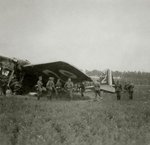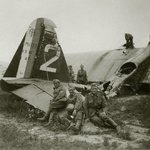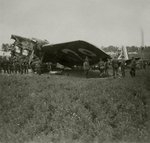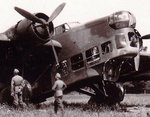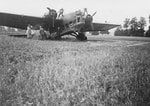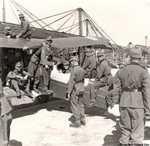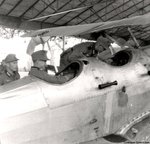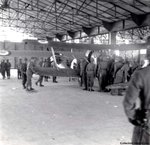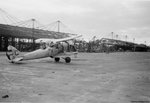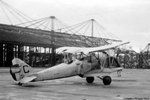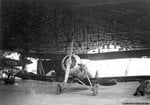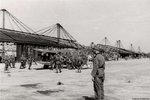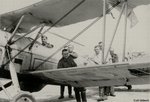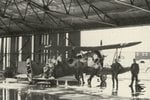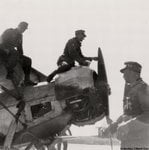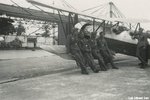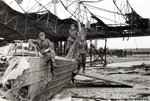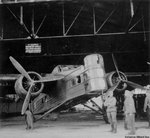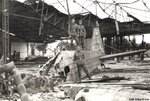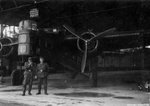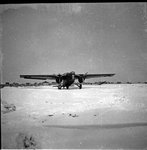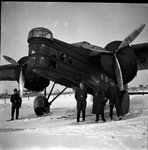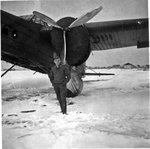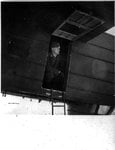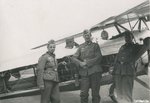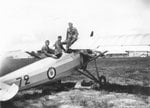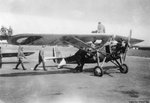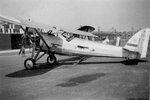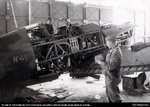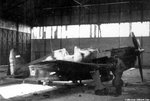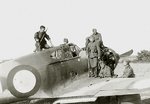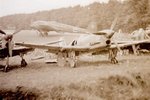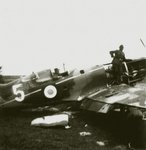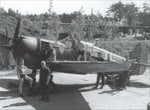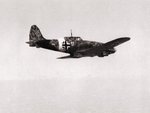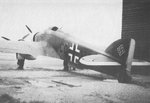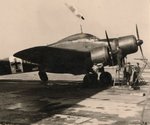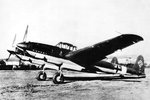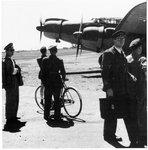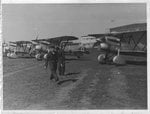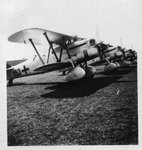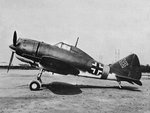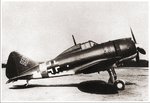Following Germany's attack on the Soviet Union, interest towards German aircraft increased considerably. Many theoretical questions evolved into questions vital for the successful defense of the country. It was hard to successfully fight the enemy in the air without exact and detailed data about Luftwaffe combat aircraft and the tactics German pilots employed. At the beginning of hostilities, the Soviet command element placed the focus on test results obtained during trials of the German airplanes bought in 1940. However, Soviet commanders of units at the operational and strategic level wondered whether the flight performance of airplanes in service with the German Air Force in June 1941 were the same as those of the aircraft that previously had been purchased and the extent to which Germany had succeeded in modernizing its aircraft fleet.
Therefore, from the first days of the war, aircraft captured undamaged became valuable trophies. Already on 23 June 1941, Ju 88A-5 No. 8260 from III/KG1 Group was hit by flak and landed near the Gulf of Riga coast. Logistics unit personnel had inspected the bomber and then several pictures of the aircraft and its components were taken for an album that was quickly published for use in Red Army Air Forces units.1 In describing the Junkers, special attention was paid to its defensive armament and the thickness of the armor plates protecting the crew. One day later, a Ju 88 belonging to II/KG54 Group made a forced landing near Kiev. According to Soviet official information, the crew comprising warrant officers H. Hermann, H. Kratz, W. Schmidt, and Corporal A. Appel decided to go over to the Red Army. The Soviet Information Bureau broadcast the following: "Having no desire to fight against the Soviet people, the fliers first dropped their bombs into the Dnepr River and then landed not far from the city7 and surrendered to local peasants. The pilots wrote an appeal called 'To German Fliers and Soldiers' in which they said: 'Fliers and soldiers, brothers, follow our example. Abandon the killer Hitler and come over here, to Russia'".
From the Combat Action Journal of the KG54 Group Death's Head, it followed that Ju 88A-6 No. 2428 had attacked Brovary Airfield, but was hit, could not continue the sortie, and had to make a forced landing. From other Junkers, it was noticed that all four crewmembers of the downed bomber left their machine safely and then were arrested by a Soviet patrol' The German version seems to be more credible. But, even when Junkers planes in good working order fell into Russian hands, the success was ordinarily used just for propaganda. As an example, on 8 July, Ju 88A-5 No. 4341 from the KG1 Squadron Hindenburg, with the engine slightly damaged by shrapnel and shells, landed 120 kilometers from Lake Chudskoye, but again no attempts were made to examine the captured aircraft. As a rule, the examination of enemy bombers and reconnaissance aircraft that fell into Soviet hands simply was confined to defining the caliber and number of their defensive guns, their elevation and depression angles, and levels of crew armor protection.
Sometimes, staff officers in rear areas went to the probable downed aircraft sites. Thus, on 25 July 1941. commanders confirmed the successful actions of Moscowt air defense fighters. They had intercepted two of three Ju 88 reconnaissance planes from the 122nd Group over the town of Istra. The plane with code F6+AO crashed, but the one with code F6+AK made a forced landing. Five days later, it was set up on Sverdlov Square in Moscow, which allowed Muscovites to see a downed enemy. At that time, Air Forces Scientific Research Institute specialists mainly concentrated their attention on refining new types of domestic aircraft being delivered in large quantities to the army in the field despite numerous defects that had not been corrected before the war. Air Forces Scientific Research Institute engineers and pilots had to wrork not only within the walls of the institute, at its airfield and testing ground, but also with line units and at series-production plants. Due attention to captured aircraft began to be paid only after 29 July, when an institute special order to establish a permanent commission to receive captured equipment was promulgated. General M. V. Shishkin, Deputy Chief of the Air Forces Scientific Research Institute, chaired the commission.
From the first days of combat, hostile fighters—the bitterest enemies of Soviet aircraft—drew the greatest attention of our aviators. They managed to inflict enormous damage on the Red Army Air Forces. In the summer and autumn of 1941, front-line pilots, navigators, and radio operator-gunners knew very little about enemy aircraft, or, unfortunately, enemy tactics very well. They did not get the appropriate information from staffs. But, even without information about Messerschmitts, bomber crews understood that the former were much faster and had cannon and heavy machine guns allowing enemy pilots to set fire to Soviet aircraft from long range, while themselves remaining essentially out of range of ShKAS machine gun fire.
The first attempt to analyze in detail the flying characteristics of German fighters came in late June 1941 following a study of the combat actions of the Pe-2 bombers assigned to the 410th Aviation Regiment operating on the Western Front. This regiment comprised the flight and maintenance personnel of the Air Forces Scientific Research Institute Bomber Aircraft Department. From 5 to 22 July, the unit flew 235 sorties and lost 33 Pe-2s, including 22 due to fire from enemy fighters. Crew debriefings gave little hope: the Messerschmitts were noticeably faster than the newest Soviet bombers. In theory, based on test flights made in 1940. Bf 109E maximum level speed should not have been much more than that of the Pe-2. The difference did not exceed 15-20 km/h at an altitude of 4000-5000 meters. But, in practice, as regimental commander Colonel A. I. Kabanov pointed out, "The German fighters easily caught up with our Pe-2s and had time to earn' out three-five attacks while pursuing them".
(Source: ??????? ?????? ???????)
Therefore, from the first days of the war, aircraft captured undamaged became valuable trophies. Already on 23 June 1941, Ju 88A-5 No. 8260 from III/KG1 Group was hit by flak and landed near the Gulf of Riga coast. Logistics unit personnel had inspected the bomber and then several pictures of the aircraft and its components were taken for an album that was quickly published for use in Red Army Air Forces units.1 In describing the Junkers, special attention was paid to its defensive armament and the thickness of the armor plates protecting the crew. One day later, a Ju 88 belonging to II/KG54 Group made a forced landing near Kiev. According to Soviet official information, the crew comprising warrant officers H. Hermann, H. Kratz, W. Schmidt, and Corporal A. Appel decided to go over to the Red Army. The Soviet Information Bureau broadcast the following: "Having no desire to fight against the Soviet people, the fliers first dropped their bombs into the Dnepr River and then landed not far from the city7 and surrendered to local peasants. The pilots wrote an appeal called 'To German Fliers and Soldiers' in which they said: 'Fliers and soldiers, brothers, follow our example. Abandon the killer Hitler and come over here, to Russia'".
From the Combat Action Journal of the KG54 Group Death's Head, it followed that Ju 88A-6 No. 2428 had attacked Brovary Airfield, but was hit, could not continue the sortie, and had to make a forced landing. From other Junkers, it was noticed that all four crewmembers of the downed bomber left their machine safely and then were arrested by a Soviet patrol' The German version seems to be more credible. But, even when Junkers planes in good working order fell into Russian hands, the success was ordinarily used just for propaganda. As an example, on 8 July, Ju 88A-5 No. 4341 from the KG1 Squadron Hindenburg, with the engine slightly damaged by shrapnel and shells, landed 120 kilometers from Lake Chudskoye, but again no attempts were made to examine the captured aircraft. As a rule, the examination of enemy bombers and reconnaissance aircraft that fell into Soviet hands simply was confined to defining the caliber and number of their defensive guns, their elevation and depression angles, and levels of crew armor protection.
Sometimes, staff officers in rear areas went to the probable downed aircraft sites. Thus, on 25 July 1941. commanders confirmed the successful actions of Moscowt air defense fighters. They had intercepted two of three Ju 88 reconnaissance planes from the 122nd Group over the town of Istra. The plane with code F6+AO crashed, but the one with code F6+AK made a forced landing. Five days later, it was set up on Sverdlov Square in Moscow, which allowed Muscovites to see a downed enemy. At that time, Air Forces Scientific Research Institute specialists mainly concentrated their attention on refining new types of domestic aircraft being delivered in large quantities to the army in the field despite numerous defects that had not been corrected before the war. Air Forces Scientific Research Institute engineers and pilots had to wrork not only within the walls of the institute, at its airfield and testing ground, but also with line units and at series-production plants. Due attention to captured aircraft began to be paid only after 29 July, when an institute special order to establish a permanent commission to receive captured equipment was promulgated. General M. V. Shishkin, Deputy Chief of the Air Forces Scientific Research Institute, chaired the commission.
From the first days of combat, hostile fighters—the bitterest enemies of Soviet aircraft—drew the greatest attention of our aviators. They managed to inflict enormous damage on the Red Army Air Forces. In the summer and autumn of 1941, front-line pilots, navigators, and radio operator-gunners knew very little about enemy aircraft, or, unfortunately, enemy tactics very well. They did not get the appropriate information from staffs. But, even without information about Messerschmitts, bomber crews understood that the former were much faster and had cannon and heavy machine guns allowing enemy pilots to set fire to Soviet aircraft from long range, while themselves remaining essentially out of range of ShKAS machine gun fire.
The first attempt to analyze in detail the flying characteristics of German fighters came in late June 1941 following a study of the combat actions of the Pe-2 bombers assigned to the 410th Aviation Regiment operating on the Western Front. This regiment comprised the flight and maintenance personnel of the Air Forces Scientific Research Institute Bomber Aircraft Department. From 5 to 22 July, the unit flew 235 sorties and lost 33 Pe-2s, including 22 due to fire from enemy fighters. Crew debriefings gave little hope: the Messerschmitts were noticeably faster than the newest Soviet bombers. In theory, based on test flights made in 1940. Bf 109E maximum level speed should not have been much more than that of the Pe-2. The difference did not exceed 15-20 km/h at an altitude of 4000-5000 meters. But, in practice, as regimental commander Colonel A. I. Kabanov pointed out, "The German fighters easily caught up with our Pe-2s and had time to earn' out three-five attacks while pursuing them".
(Source: ??????? ?????? ???????)

